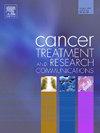Low to intermediate grade lung neuroendocrine tumours. A single centre real world experience
IF 2.4
Q3 Medicine
引用次数: 0
Abstract
Introduction
Lung neuroendocrine tumours (LNETs) are a rare heterogenous group of tumours whose incidence has been increasing. We investigated the diagnosis, treatment, and survival patterns of patients with low to intermediate grade LNETs.
Methods
A retrospective chart review of patients with low to intermediate grade LNETs, treated at a Canadian tertiary-level cancer centre was performed.
Results
We identified 59 patients. Most were G1or G2 and well or moderately differentiated. Forty-seven patients presented with local or locally advanced disease, of which 57.4 % received curative intent surgery. The rest were treated with definitive radiation, radical chemoradiation with platinum and etoposide, palliative chemotherapy with doxorubicin, or supportive care. The five-year overall survival (OS) for those treated surgically was 83 % versus 44 % in the non-surgical group. Metastatic disease was seen in 24/59 patients, with a five-year OS in patients with stage IV disease of 39 %. Of those with advanced or unresectable disease (n = 32), 21 received palliative systemic treatment with up to three lines of therapy. First-line treatment was most commonly chemotherapy with platinum/etoposide combination or somatostatin analogue therapy. Second-line treatment involved chemotherapy or targeted everolimus. PRRT was used once as a first-line and once as second-line therapy. Third-line included lanreotide or chemotherapy with capecitabine/temozolomide combination.
Conclusion
Overall, patients with surgically resectable disease had a good five-year OS. However, inoperable or more advanced disease was associated with a poorer OS. Despite many treatment options, the sequence of treatments is poorly established. This highlights the need for further development and dissemination of evidence-based guidelines for LNET patients.
中低度肺神经内分泌肿瘤。单个中心的实际经验。
简介肺神经内分泌肿瘤(LNETs)是一种罕见的异质性肿瘤,其发病率呈上升趋势。我们对中低级别 LNET 患者的诊断、治疗和生存模式进行了调查:我们对在加拿大一家三级癌症中心接受治疗的中低级别 LNET 患者进行了回顾性病历审查:结果:我们发现了 59 名患者。大多数为 G1 或 G2,分化良好或中度。47名患者出现局部或局部晚期疾病,其中57.4%接受了根治性手术。其余患者接受了确定性放射治疗、铂类和依托泊苷根治性化疗、多柔比星姑息化疗或支持治疗。手术治疗组的五年总生存率(OS)为 83%,而非手术治疗组为 44%。24/59例患者出现了转移性疾病,IV期患者的五年生存率为39%。在晚期或无法切除的患者(32 人)中,21 人接受了多达三种疗法的姑息性全身治疗。一线治疗最常见的是铂/依托泊苷联合化疗或体生长抑素类似物疗法。二线治疗包括化疗或靶向依维莫司。PRRT作为一线疗法和二线疗法各使用过一次。三线治疗包括兰瑞肽或卡培他滨/替莫唑胺联合化疗:总的来说,可手术切除的患者五年的OS良好。结论:总体而言,可手术切除的患者的五年生存率较高,但无法手术或病情较晚的患者的生存率较低。尽管治疗方案很多,但治疗顺序还不太确定。这凸显了为LNET患者进一步制定和传播循证指南的必要性。
本文章由计算机程序翻译,如有差异,请以英文原文为准。
求助全文
约1分钟内获得全文
求助全文
来源期刊

Cancer treatment and research communications
Medicine-Oncology
CiteScore
4.30
自引率
0.00%
发文量
148
审稿时长
56 days
期刊介绍:
Cancer Treatment and Research Communications is an international peer-reviewed publication dedicated to providing comprehensive basic, translational, and clinical oncology research. The journal is devoted to articles on detection, diagnosis, prevention, policy, and treatment of cancer and provides a global forum for the nurturing and development of future generations of oncology scientists. Cancer Treatment and Research Communications publishes comprehensive reviews and original studies describing various aspects of basic through clinical research of all tumor types. The journal also accepts clinical studies in oncology, with an emphasis on prospective early phase clinical trials. Specific areas of interest include basic, translational, and clinical research and mechanistic approaches; cancer biology; molecular carcinogenesis; genetics and genomics; stem cell and developmental biology; immunology; molecular and cellular oncology; systems biology; drug sensitivity and resistance; gene and antisense therapy; pathology, markers, and prognostic indicators; chemoprevention strategies; multimodality therapy; cancer policy; and integration of various approaches. Our mission is to be the premier source of relevant information through promoting excellence in research and facilitating the timely translation of that science to health care and clinical practice.
 求助内容:
求助内容: 应助结果提醒方式:
应助结果提醒方式:


